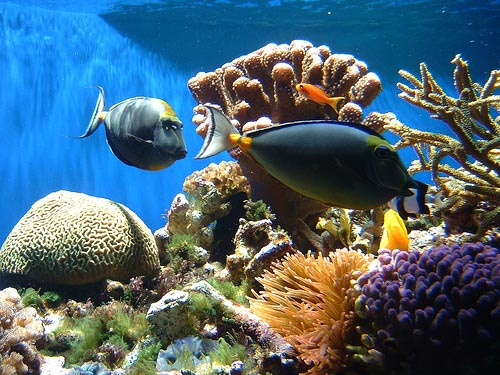- What do corals composed of?
- How do corals grow?
- Which is considered as the "rainforests of the ocean?
- What medical benefits can we get from chemical compounds extracted from coral reefs?

Picture of a Coral Reef, home of the fishes.
What are corals?
Corals are colorless and transparent. The lovely colors that we see in corals come from the algae, called zooxan-thellae, which give corals their color. Corals live in a symbiotic relationship with these algae in order to survive. Attractive colors are not the only thing algae provide corals; they too supply them food and oxygen.
What do corals composed of?
A coral appears to be a single organism; but it is actually a group of many individual, yet identical, soft-bodied animals called polyps. Corals come in many shapes. They can be shaped like domes, organ pipes and trees.
What are the environmental benefits of corals?
Aside from the entrancing beauty we can behold whenever we go scuba diving or snorkeling, corals are also very useful as protection against hurricanes, wave erosion, and other extreme weather conditions.
What are the health benefits of corals to humans?
Coral reefs also provide medical benefits for humans. Chemical compounds taken from corals are used in medicine for cancer. Acquired Immune Deficiency Syndrome (AIDS), pain and other uses. Corals are also commonly used as living bone implants for humans.
Corals are highly sensitive to environmental changes. Scientists have predicted that over 50% of the world's coral reefs may be destroyed by 2030. As a result, most nations protect them through environmental laws.
In the Philippines, we have the Clean Water Act and the National Integrated Protected Areas System (NIPAS) Act.
The Clean Water Act helps ensure that we maintain clean waterways so that waters that pass through the oceans are crystal clear. Corals are sensitive; they only thrive in clean water. If we pollute the waters, they die. The NIPAS Act shall also help conserve, protect and maintain seascapes and PAs (protected areas) that shelter our remaining coral reefs.
How do corals grow?
Coral Reefs tend to grow slowly, increasing in size of about less than three centimeters each year. If we continue on destroying coral reefs by persisting in our destructive ways, it would take us several years before another coral reef the size of a basketball could form.
What should we do to help save our coral reefs?
- Let us clean up our rivers and all waterways, and stop throwing litter irresponsibly.
- Let us reduce our carbon footprint by lessening the use of electricity in our homes (yes, less playing time on the computer and more time for reading books and helping mom and dad).
- Practice the 3 Rs on waste management (reduce, reuse, recycle)
- Let us not throw trash on our oceans and waterways.